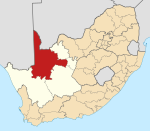Kakamas
Kakamas | |
|---|---|
 A water wheel in Kakamas | |
| Coordinates: 28°48′S 20°39′E / 28.800°S 20.650°E | |
| Country | South Africa |
| Province | Northern Cape |
| District | ZF Mgcawu |
| Municipality | Kai !Garib |
| Established | 1898 |
| Area | |
| • Total | 4.55 km2 (1.76 sq mi) |
| Elevation | 670 m (2,200 ft) |
| Population (2011)[1] | |
| • Total | 9,538 |
| • Density | 2,100/km2 (5,400/sq mi) |
| Racial makeup (2011) | |
| • Black African | 7.0% |
| • Coloured | 81.6% |
| • Indian/Asian | 0.9% |
| • White | 9.6% |
| • Other | 1.0% |
| First languages (2011) | |
| • Afrikaans | 93.5% |
| • Tswana | 2.3% |
| • English | 1.6% |
| • Other | 2.7% |
| Time zone | UTC+2 (SAST) |
| Postal code (street) | 8870 |
| PO box | 8870 |
| Area code | 054 |
Kakamas[2] is a town founded in 1898 and located in the Northern Cape province of South Africa, on the banks of the Orange River.
Originated as at a place where the Orange River could be relatively easily crossed. The spot was first known as Bassonsdrif. In 1898 a proper settlement was established and under the auspices of the Dutch Reformed Church the area was developed as an agricultural spot. It became a municipality in 1954.[3]
History

The small town of Kakamas was built on the sheer hard work and determination of a couple of impoverished stock farmers at the end of the 19th century. The drought of 1895–97 was followed by an outbreak of rinderpest, leaving many farmers destitute.
In 1897, the Dutch Reformed Church started a "colony" on the farms Soetap and Kakamas on the banks of the Orange River for white people who had lost everything as a result of the drought[4].
Ignoring the criticism of qualified engineers about their building methods, the farmers continued to construct the water canals by hand that are still used today to supply the town and surrounding area with water for irrigation. For their efforts, they were each awarded the right to one of the irrigation plots. The men worked extremely hard even taking the yoke themselves, rather than wasting precious time in launching a time consuming search for oxen and donkeys grazing somewhere in the veld.
The exceptional dry piling of the stone along rocky slopes can still be seen today. By dry piling instead of excavating through rock, the farmers were able to cut the overall costs of the canals considerably.
The ingenuity of the workers under the leadership of Japie Lutz is aptly demonstrated in the workmanship at the water tunnels in the northern canal. Mr Piet Burger perfected the water wheel that was widely used in Kakamas. This pumping device almost led to a court case about patent rights, when a blacksmith who used to live in Kakamas registered the patent in 1922.
The Commission that ran the "colony" planned ahead and in 1912 building operations on a hydro-electric power station and turbine in the northern canal were started. Ultimately the power station, built to look like an Egyptian temple, generated enough electricity that Kakamas liaised with Upington about the possibility of supplying Upington with electricity as well.
Economy
The economy of this town is based on farming, and thanks to irrigation from the Orange River farmers from the Kakamas area are now prime exporters of table grapes to Europe and England. The region also exports peaches, dried fruit, raisins, oranges and dates.
Name origins
The name Kakamas was originally given to a drift that was known as Takemas or T’Kakamas since 1779. The name means "place of the raging cow" – probably referring to an incident when a raging cow stormed the Korana while they were herding their cattle through this ford.
To some the town's name originates from the Khoi word "gagamas" (brown), referring to the red clay of the area with which women daub their faces. To most, though, Kakamas is a Korana word meaning "poor pasture".
Today, the name reflects poorly on a fertile valley in the Lower Orange River, graced with vineyards, cotton and lucern fields.
2016 tragedy
Kakamas entered the headlines in January 2016 when five children from one family suffocated and died in an old freezer in which they were playing. When the lid accidentally fell into its lock they were unable to open it from the inside.[5][6][7][8]
Notes
- ^ a b c d "Main Place Kakamas". Census 2011.
- ^ "Green Kalahari – Kakamas, name origins". Archived from the original on 20 May 2008. Retrieved 27 August 2008.
- ^ Kakamas – municipality Archived 11 February 2012 at the Wayback Machine
- ^ Raper, R.E. (1987). "Dictionary of Southern African Place Names". Human Science Research Council. p. 235. Retrieved 4 December 2013.
- ^ See: Freezer tragedy rocks Kakamas, IOL-News, (21 januari 2016). Accessed on 21 January 2016.
- ^ See: Five children found dead inside freezer after becoming trapped while playing, Mirror, UK. 20 January 2016. Accessed on 21 January 2016.
- ^ See: Oma vindt vijf kleinkinderen dood in vriezer, De Telegraaf (a Dutch newspaper), 20 January 2016. Accessed on 21 January 2016.
- ^ See: onyon-deaths Police open inquest into Kakamas freezer deaths, Eyewitness News, 20 January 2016. Accessed on 21 January 2016.



